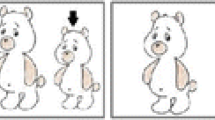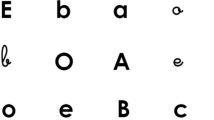Abstract
Recent research has established that 5- to 6-year-old typically developing children in a left–right writing culture spontaneously reverse left-oriented characters (e.g., they write  instead of J) when they write single characters. Thus, children seem to implicitly apply a right-writing rule (RWR: see Fischer & Koch, 2016a). In Study 1, the reversal of all asymmetrical digits and capital letters by 356 children was modeled with a simple Rasch model, which describes reversal as the outcome of two competing responses, correct writing and writing in the cultural direction of writing. It accounts for the high frequency of reversals of the left-oriented characters (3, Z, J, 1, 2, 7, 9), as predicted by the RWR. Study 2 investigated letter reversals when children spontaneously write their name from right to left. Most of the 204 children in the study radically changed the direction of the RWR by reversing mainly the right-oriented letters (B, C, D, E, F, G, K, L, N, P, R, S). Hence, a more universal formulation of the RWR would be as an implicit rule orienting characters in the writing direction. This reformulated rule is consistent with the “spatial agency bias” model (Suitner & Maas, 2016), according to which writing direction affects thoughts and actions. Visual and motoric statistical learning may favor bootstrapping of the rule. Taken together, these data demonstrate the prominent role of culture in a phenomenon—character reversal or mirror writing—which has often been presented uniquely as biologically determined.
instead of J) when they write single characters. Thus, children seem to implicitly apply a right-writing rule (RWR: see Fischer & Koch, 2016a). In Study 1, the reversal of all asymmetrical digits and capital letters by 356 children was modeled with a simple Rasch model, which describes reversal as the outcome of two competing responses, correct writing and writing in the cultural direction of writing. It accounts for the high frequency of reversals of the left-oriented characters (3, Z, J, 1, 2, 7, 9), as predicted by the RWR. Study 2 investigated letter reversals when children spontaneously write their name from right to left. Most of the 204 children in the study radically changed the direction of the RWR by reversing mainly the right-oriented letters (B, C, D, E, F, G, K, L, N, P, R, S). Hence, a more universal formulation of the RWR would be as an implicit rule orienting characters in the writing direction. This reformulated rule is consistent with the “spatial agency bias” model (Suitner & Maas, 2016), according to which writing direction affects thoughts and actions. Visual and motoric statistical learning may favor bootstrapping of the rule. Taken together, these data demonstrate the prominent role of culture in a phenomenon—character reversal or mirror writing—which has often been presented uniquely as biologically determined.




Similar content being viewed by others
Notes
The percentages of reversed and correct writings were manifestly inverted in Ritchey’s (2008, p. 37) graph (or in the legend). For comparison, we estimated the percentage of reversals by measuring on the graph the number of reversals and the absence of writings (correct or reversed) for each of the 15 asymmetrical capital letters.
The probability of a participant, p, reversing an item, i, can be derived from the basic formula given at the beginning of Study 1: p pi = [exp(θp − βi)]/[1 + exp(θp − βi)].
The letters (J and Z) were dictated three times: only the first writing was included in the data. The digit writings are not analyzed in this study.
References
Andersen, E. B. (1973). A goodness of fit test for the Rasch model. Psychometrika, 38, 123–140. doi:10.1007/BF02291180.
Casasanto, D., & Bottini, R. (2014). Mirror reading can reverse the flow of time. Journal of Experimental Psychology: General, 143, 473–479. doi:10.1037/a0033297.
Chokron, S., Bartolomeo, P., Perenin, M. T., Helft, G., & Imbert, M. (1998). Scanning direction and line bisection: A study of normal subjects and unilateral neglect patients with opposite reading habits. Cognitive Brain Research, 7, 173–178. doi:10.1016/S0926-6410(98)00022-6.
Chokron, S., & De Agostini, M. (2000). Reading habits influence aesthetic preference. Cognitive Brain Research, 10, 45–49. doi:10.1016/S0926-6410(00)00021-5.
Christophe, A., Millotte, S., Bernal, S., & Lidz, J. (2008). Bootstrapping lexical and syntactic acquisition. Language and Speech, 51, 61–75. doi:10.1177/00238309080510010501.
Cohen, J. (1988). Statistical power analysis for the behavioral sciences (2nd ed.). New York, NY: Taylor & Francis.
Corballis, M. C., & Beale, I. L. (1976). The psychology of left and right. New York, NY: Erlbaum.
Cornell, J. (1985). Spontaneous mirror-writing in children. Canadian Journal of Psychology, 39, 174–179. doi:10.1037/h0080122.
Dehaene, S. (2010). Reading in the brain. New York, NY: Penguin Viking.
Erickson, L. C., & Thiessen, E. D. (2015). Statistical learning of language: Theory, validity, and predictions of a statistical learning account of language acquisition. Developmental Review, 37, 66–108. doi:10.1016/j.dr.2015.05.002.
Fischer, J. P. (2010). Vers une levée du mystère des écritures en miroir (des chiffres) chez l’enfant [Digit mirror-writing in children: Towards an unlocking of the mystery]. L’année psychologique, 110, 227–251. doi:10.4074/S0003503310002034.
Fischer, J. P. (2013). Digit reversal in children’s writing: A simple theory and its empirical validation. Journal of Experimental Child Psychology, 115, 356–370. doi:10.1016/j.jecp.2013.02.003.
Fischer, J. P., & Koch, A. M. (2014). La magie computationnelle de la voie ventrale est-elle à l’origine de l’inversion des lettres et des chiffres chez l’enfant de cinq à six ans ? [Does the reversal of the letters and digits by the five to six-year-old child originate in the computational magic of the ventral stream?]. Revue de Neuropsychologie, 6, 230–237. doi:10.1684/nrp.2014.0318.
Fischer, J. P., & Koch, A. M. (2016a). Mirror writing in 5- to 6-year-old children: The preferred hand is not the explanation. Laterality: Asymmetries of Body, Brain and Cognition, 21, 34–49. doi:10.1080/1357650X.2015.1066383.
Fischer, J. P., & Koch, A. M. (2016b). Mirror writing in typically developing children: A first longitudinal study. Cognitive Development, 38, 114–124. doi:10.1016/j.cogdev.2016.02.005.
Fischer, J. P., & Tazouti, Y. (2012). Unraveling the mystery of mirror writing in typically developing children. Journal of Educational Psychology, 104, 193–205. doi:10.1037/a0025735.
Flieller, A. (1994). Méthodes d’étude de l’adéquation au modèle logistique à un paramètre (modèle de Rasch) [Methods of assessment of Rasch’s model-data fit: A review]. Mathématiques et Sciences Humaines, 127, 19–47.
Gordon, H. (1921). Left-handedness and mirror writing, especially among defective children. Brain, 43, 313–368. doi:10.1093/brain/43.4.313.
Hildreth, G. (1950). The development and training of hand dominance: IV. Developmental problems associated with handedness. Journal of Genetic Psychology, 76, 39–100. doi:10.1080/08856559.1950.10533526.
Ireland, W. W. (1881). On mirror-writing and its relation to left-handedness and cerebral disease. Brain, 4, 361–367. doi:10.1093/brain/4.3.361.
Kiefer, T., Robitzsch, A., & Wu, M. (2016). Package ‘TAM’: Test analysis modules (version 1.16-0). Retrieved from: https://cran.r-project.org/web/packages/TAM/TAM.pdf on February 6, 2016.
Lebrun, Y., Devreux, F., & Leleux, C. (1989). Mirror-writing. In P. G. Aaron & R. M. Joshi (Eds.), Reading and writing disorders in different orthographic systems (pp. 355–378). Dordrecht: Kluwer Academic Publishers.
Maass, A., Suitner, C., & Deconchy, J. P. (2014). Living in an asymmetrical world: How writing direction affects thought and action. London: Psychology Press.
Maass, A., Suitner, C., & Nadhmi, F. (2014). What drives the spatial agency bias? An Italian–Malagasy–Arabic comparison study. Journal of Experimental Psychology: General, 143, 991–996. doi:10.1037/a0034989.
Mair, P., & Hatzinger, R. (2007). Extended Rasch modeling: The eRm package for the application of IRT models in R. Journal of Statistical Software, 20(9), 1–20. doi:10.18637/jss.v020.i09.
Maydeu-Olivares, A. (2013). Goodness-of-fit assessment of item response theory models. Measurement: Interdisciplinary Research and Perspectives, 11(3), 71–101. doi:10.1080/15366367.2013.831680.
McIntosh, R. D., & Della Sala, S. (2012). Mirror-writing. The Psychologist, 25, 742–746.
Oosterhof, N. N., Wiggett, A. J., Diedrichsen, J., Tipper, S. P., & Downing, P. E. (2010). Surface-based information mapping reveals crossmodal vision-action representations in human parietal and occipitotemporal cortex. Journal of Neurophysiology, 104, 1077–1089. doi:10.1152/jn.00326.2010.
R Core Team. (2015). R: A language and environment for statistical computing. Vienna (Austria): R Foundation for Statistical Computing. https://www.R-project.org/.
Ritchey, K. D. (2008). The building blocks of writing: Learning to write letters and spell words. Reading and Writing: An Interdisciplinary Journal, 21, 27–47. doi:10.1007/s11145-007-9063-0.
Román, A., Flumini, A., Lizano, P., Escobar, M., & Santiago, J. (2015). Reading direction causes spatial biases in mental model construction in language understanding. Scientific Reports, 5(18248), 1–8. doi:10.1038/srep18248.
Scheidemann, N. V. (1936). Inverse writing: A case of consistent mirror writing. The Pedagogical Seminary and Journal of Genetic Psychology, 48, 489–494. doi:10.1080/08856559.1936.10533745.
Shuttleworth, S. (2010). The mind of the child: Child development in literature, science, and medicine, 1840–1900. Oxford: Oxford University Press.
Spencer, M., Kaschak, M. P., Jones, J. L., & Lonigan, C. J. (2015). Statistical learning is related to early literacy-related skills. Reading and Writing: An Interdisciplinary Journal, 28, 467–490. doi:10.1007/s11145-014-9533-0.
Suitner, C. (2009). Where to place social targets? Stereotyping and spatial agency bias. Retrieved from http://paduaresearch.cab.unipd.it/1756/1/tesi_suitner.pdf on April 8, 2016.
Suitner, C., & Maass, A. (2016). Spatial agency bias: Representing people in space. Advances in Experimental Social Psychology, 53, 245–301. doi:10.1016/bs.aesp.2015.09.004.
Thompson, B., Kirby, S., & Smith, K. (2016). Culture shapes the evolution of cognition. PNAS, 113, 4530–4535. doi:10.1073/pnas.1523631113.
Treiman, R., & Allaith, Z. (2013). Do reading habits influence aesthetic preferences? Reading and Writing: An Interdisciplinary Journal, 26, 1381–1386. doi:10.1007/s11145-012-9424-1.
Treiman, R., Gordon, J., Boada, R., Peterson, R. L., & Pennington, B. F. (2014). Statistical learning, letter reversals, and reading. Scientific Studies of Reading, 18, 383–394. doi:10.1080/10888438.2013.873937.
Treiman, R., & Kessler, B. (2011). Similarities among the shapes of writing and their effects on learning. Written Language and Literacy, 14, 39–57. doi:10.1075/wll.14.1.03tre.
Wilson, M., & De Boeck, P. (2004). Descriptive and explanatory item response models. In P. de Boeck & M. Wilson (Eds.), Explanatory item response models: A generalized linear and nonlinear approach (pp. 43–74). New York, NY: Springer.
Author information
Authors and Affiliations
Corresponding author
Rights and permissions
About this article
Cite this article
Fischer, JP. Character reversal in children: the prominent role of writing direction. Read Writ 30, 523–542 (2017). https://doi.org/10.1007/s11145-016-9688-y
Published:
Issue Date:
DOI: https://doi.org/10.1007/s11145-016-9688-y




